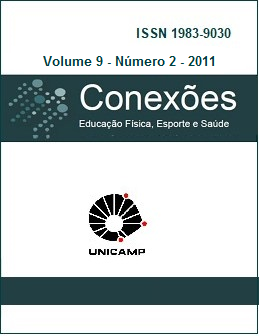Abstract
O treinamento de força (TF) - também denominado treinamento com pesos - refere-se a um método especializado de condicionamento físico que envolve o uso progressivo de cargas resistivas desenvolvidas para aumentar ou manter a aptidão muscular. Atualmente o número de jovens engajados em programas de treinamento que incluem o TF está crescendo de forma vertiginosa. Tendo isso em vista, o objetivo dessa presente revisão é relatar os principais aspectos relacionados à segurança e à eficácia do TF em crianças e jovens e apresentar linhas de orientação desenvolvidas especificamente para essa população. O método utilizado foi uma revisão sistemática com a localização de artigos publicados entre 1993 e 2001 nas bases de dados PubMed, Scielo e Scopus. As evidências científicas encontradas nos estudos analisados indicam que o TF é saudável e apresenta diversos benefícios para crianças e adolescentes quando esses são instruídos, apropriadamente, por instrutores qualificados que se baseiam em linhas de orientação corretas de treino. Assim sendo, o TF pode ser praticado por crianças, pois se apresenta de forma segura e benéfica à saúde dessa população.References
FAIGENBAUM, A. D. Resistance training among young athletes: safety, efficacy and injury prevention effects. British Journal of Sports Medicine, v. 44, n. 4, p. 56-63, abr. 2010.
COUTTS, A.; MURPHY, A.; DASCOMBE, B. Effect of direct supervision of a strength coach on measures of muscular strength and power in young rugby league players. Journal of Strength and Conditioning Research, v.18, n.2, p.316-323, mar. 2004.
OLSEN, O.; MYKLEBUST, G.; ENGEBRETSEN, L. Exercises to prevent lower limb injuries in youth sports: cluster randomised controlled trial. British Medical Journal, v. 26, n. 2, p.330-449, fev. 2005.
FAIGENBAUM, A. D. et al. Youth resistance training: updated position statement paper from the National Strength and Conditioning Association. Journal of Strength and Conditioning Research, v. 23, n. 5, p. 60-79, jan. 2009.
BLIMKIE, C. J. Resistance training during preadolescence: issues and controversies. Sports Medicine, v.15, p.389-407, jun. 1993.
AMERICAN ACADEMY OF PEDIATRICS COUNCIL ON SPORTS MEDICINE AND FITNESS. Strength training by children and adolescents. Pediatrics, v.121, n. 4, p. 835-840, abr. 2008.
HAMILL, B. Relative safety of weightlifting and weight training. Journal of Strength and Conditioning Research, v. 8, n.1, p. 53-57, out. 1994.
CENTERS FOR DISEASE CONTROL AND PREVENTION. Sports-related injuries among high school athletes: United States, 2005-06 school year. Morbidity and Mortality Weekly Report, v. 55, n.38, p.1037-1040, set. 2006.
MARGINSON, V. et al.Comparison of the symptoms of exercise-induced muscle damage after an initial and repeated bout of plyometric exercise in men and boys. Journal Applied of Physiology, v. 99, n.5, p.1174-1181, abr. 2005.
CLARKSON, P. M. Case report of exertional rhabdomyolysis in a 12-year-old boy. Medicine and Science in Sports and Exercise, v.38, n.2, p.197-200, mar. 2006.
KERR, Z.Y., COLLINS, C. L., COMSTOCK, R. D. Epidemiology of weight training-related injuries presenting to United States Emergency Departments, 1990 to 2007. American Journal of Sports Medicine, v. 38, n.7, p.765-771, mar. 2010.
LILLEGARD W. A.; BROWN E.W.; WILSON D. J. Efficacy of strength training in prepubescent to early postpubescent males and females: effects of gender and maturity. Pediatric Rehabilitation, v.1, n.3, p.147-157, fev. 1997.
FAIGENBAUM, A. D.; MILLIKEN L. A.; LOUD R. L. Comparison of 1 and 2 days per week of strength training in children. Research Quarterly for Exercise and Sport, Estados Unidos da América, v.73, n. 4, p.416-424, dez. 2002.
FAIGENBAUM A. D.; MILLIKEN L. A.; MOULTON L. Early muscular fitness adaptations in children in response to two different resistance training regimens. Pediatric Rehabilitation, v.17, n.3, p.237-248, ago. 2005.
FAIGENBAUM, A.D.; MYER, G.D. Youth resistance training. President's Council on Physical Fitness and Sports Research Digest, v. 4, n. 3, p.1-8, set. 2003.
CAINE, D.; MAFFULLI, N.; CAINE, C. Epidemiology of Injury in Child and Adolescent Sports: Injury Rates, Risk Factors, and Prevention. Clinical Journal of Sport Medicine, v. 27, n.1, p.19-50, jan. 2008.
MICHELI, L.; GLASSMAN, R.; KLEIN, M. The prevention of sports injuries in children. Clinical Journal of Sport Medicine, v.19, n.5, p.821-834, ago. 2000.
FAIGENBAUM, A. et al. Youth Resistance training: position statement paper and literature review. Strength and Conditioning Journal, v.18, n.6, p. 62-75, nov. 1996.
BENSON, A.C.; TORODE, M.E.; FIATARONE, M. A. Effects of resistance training on metabolic fitness in children and adolescents: a systematic review. Obesity Reviews, v.9, n.1, p. 43-66, jan. 2008.
LAU, P.W.C. et al. Effects of short: term resistance traning on serum leptin levelsin obese adolescents. Journal of Exercise Science and Fitness, v. 8, n.1, p. 54-60, mar. 2010.
MORRIS, F.; NAUGHTON, G.; GIBBS, J. Prospective ten-month exercise intervention in premenarcheal girls: positive effects on bone and lean mass. Journal of Bone and Mineral Research, v.12, n. 9, p.1453-1462, set.1997.
IGNJATOVIC, A.; RADOVANOVIC, D.; STANKOVIC, R. Influence of strength training program on isometric muscle strength in young athletes. Acta Medica Medianae. v. 46, n.1, p.16-20, jan. 2007.
FAIGENBAUM, A. D. Strenght training for children and adolescents. Clinics in Sports Medicine, v.19, n.4, p.593-618, set. 2000.
BRAGA, F. et al. Benefícios do treinamento de força para crianças e adolescentes escolares. Disponível em: http://www.efdeportes.com/efd119/treinamento-de-forca.htm. Acesso em: 12 set. 2010.
The Conexões: Educação Física, Esporte e Saúde Journal uses the license of Creative Commons (CC), thus preserving the integrity of articles in an open access environment.

